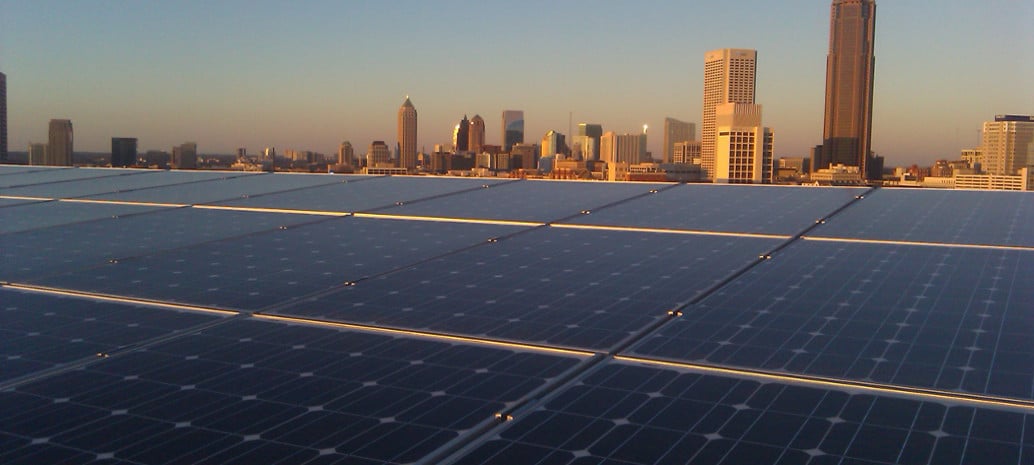The solar market in Georgia – and the entire U.S. South – just got a big boost.
In a meeting approving Georgia Power’s long-term plan, the Georgia Public Service Commission (GPSC) has required that the utility procure 2.21 GW of solar over the next five years, a sharp increase from Georgia Power’s earlier plans to source only 1 GW.
This will include both distributed and utility-scale solar in four separate tranches, and in two series of solicitations in 2020 and 2021, with capacity to come online through 2024. This will roughly double the volume of solar in the state. While Solar Energy Industries Association (SEIA) estimates that Georgia had 1.57 GW of solar at the end of the first quarter of 2019, GPSC projects that the state will have 2.4 GW online by the end of the year.
The four separate tranches:
- 1000 MW of utility-scale for large C&I customers through the Customer Renewable Supply & Procurement program (CRSP). Minimum project size: 3 MW
- 1000 MW of utility-scale through competitive solicitations. Minimum project size: 3 MW
- 160 MW of distributed generation through competitive solicitations. Project size: 1 kW – 3 MW
- 50 MW of distributed generation, customer-sited and paid under avoided cost. Project size: 1 kW – 3 MW
Contracts for the 160 MW of distributed generation will be up to 30 years. The details have not been worked out yet for the other tranches, however Kurt Ebersbach, the energy and air quality attorney at Southern Environmental Law Center (SELC), notes that contracts in past iterations of Georgia Power’s program have been for around 30 years.
The only exception is the CRSP program where Ebersbach expects 10-year contracts, as the large commercial and industrial customers whom the program serves prefer shorter contract lengths.
Projects under the 2020 and 2021 solicitations are planned to come online from 2022 through 2024, which means that if they are started soon enough these projects will qualify for some portion of the federal Investment Tax Credit (ITC) before it falls to 10%.
Under the IRP Georgia Power is also planning to begin a pilot program to use grid-tied lithium-ion batteries for EV charging. Various sources including commissioners and advocates have stated that the plan mandates 80 MW of energy storage, but it is not clear if this is in addition to this pilot program or including it.
Birth of DG in Georgia
The inclusion of 210 MW of distributed generation will dramatically increase the amount of rooftop solar in Georgia, which has built almost exclusively large-scale solar to date. Georgia Power has been particularly successful in stifling the state’s residential sector, which has been noted by solar advocates.
Today I learned: only 43 homeowners installed solar in the state of Georgia in all of 2018. Forty. Three. For comparison – FL: 11,610 & SC: 5,708
— Maggie Sasser (@magsass) July 9, 2019
But most of the distributed generation is likely to be on the large side. 150 MW of the 210 MW of DG set aside will be run through competitive solicitations. Systems up to 3 MW can qualify, and as bigger means cheaper, you can expect a lot of very large projects on the roofs of big box superstores.
The remaining 50 MW will be provided a flat rate based on levelized projected avoided cost, and advocates expect this flat rate to mean a lot of smaller installations. And while avoided cost has typically not supplied the level of revenue to make the numbers pencil for distributed generation, Ebersbach of SELC notes that as avoided cost will be calculated over the course of decades, that this number is likely to be much higher than the 3-4 cents that wholesale rates hover around in much of the South.
Pro-solar Republicans
At the federal level, the Republican Party has shown limited support for expanded deployment of renewable energy, and even at the state level the party has been resistant to policies that mandate renewables and that tie renewable energy deployment to addressing climate change.
However Georgia’s solar market owes its existence to Republican politicians on the Georgia Public Service Commission. In particular, Chair Lauren “Bubba” McDonald (R) and Vice-Chair Tim Echols (R) have been staunch supporters of solar, and together pushed Georgia Power to begin installing solar in its service area beginning with Georgia Power’s 2013 IRP.
Bubba introduced the motion that passed today to require Georgia Power to increase the solar component of its long-term plan, and Echols proudly broke the news on Twitter.
BREAKING: Public Service Commission approves largest single acquisition of solar in state’s history. Pilot programs for 2nd life batteries as well as 80mw of utility batteries approved. Low income “pay as you save” pilot created. STEM program expanded. Lots to cheer about today. pic.twitter.com/QG3mvdRiTa
— Tim Echols (@timechols) July 16, 2019
In particular, the GSPC has emphasized the cost advantages of solar. “I determined Georgia has the ability to add significantly more renewable energy and solar energy using a market-based approach without any upward pressure on the rate payers and no state subsidies,” stated McDonald.
This content is protected by copyright and may not be reused. If you want to cooperate with us and would like to reuse some of our content, please contact: editors@pv-magazine.com.









Billions of tax payer dollars in a nuclear power project given to Ga Power monopoly by the PSC, now more handouts for corporate projects and yet again no incentives for the individual homeowner-taxpayer. PSC disappoints!!! Georgia Power needs competition.
Where are the handouts that you refer to for the corporate projects? I don’t see any additional subsidies here beyond the federal tax credit that all solar projects receive – rooftop or large-scale.
I find it interesting that the “required” energy storage seems to be the top number mentioned in the FERC 841 determination. Interesting interpretation for a total for a total 2.2GW project. It has been said that Georgia pushes back on alternative energy and distributed generation and energy storage.
Christian, perhaps you can help folks out by getting out the word. The government has used OUR tax monies to establish the (dsire) information web site. It has all 50 States of the Union and with a click on your State you can see the MANY programs for energy efficiency and the installation of alternate energy systems on one’s property. This would be Justin’s site and everyone else in Georgia.
http://www.dsireusa.org